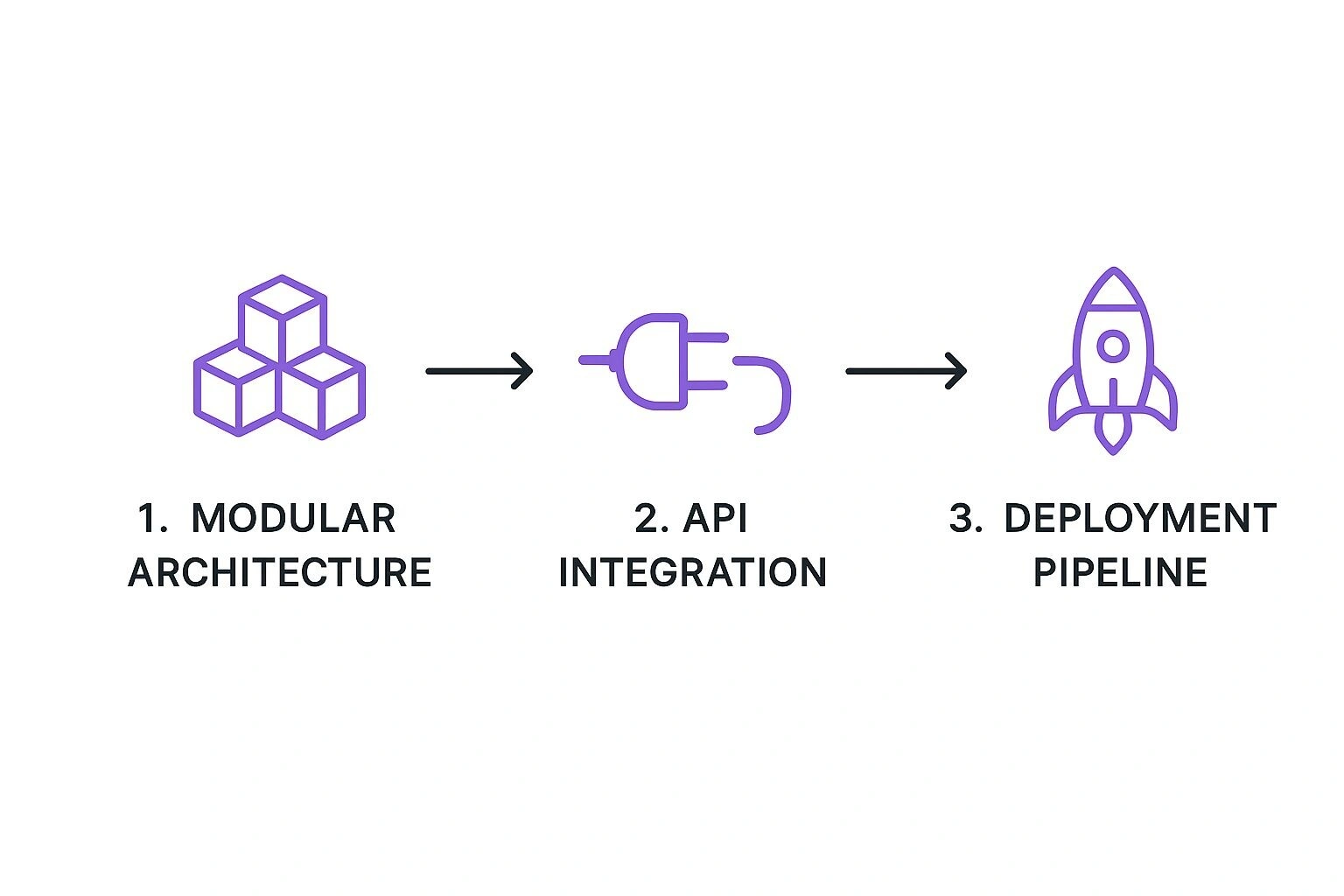What Is OpenAI AgentKit? A Simple Guide for the Curious
Confused about OpenAI AgentKit? This guide explains what it is, how it works, and why it’s a game-changer for building AI agents that can actually do things.

So, you’ve heard this new term ‘OpenAI AgentKit’ floating around and you’re probably wondering what on earth it is. Is it another AI buzzword? A complicated tool for tech wizards?
Let’s cut through the noise. I’ll explain it like we’re grabbing a coffee.
Essentially, OpenAI AgentKit is a new, open-source toolkit designed to help developers build AI assistants that can actually do things. Think of it as the next step up from a simple chatbot. It’s for creating AI that can autonomously perform tasks, moving way beyond just answering questions.
So, What Is OpenAI AgentKit Anyway?

When I first started tinkering with AI development, it felt a bit like trying to build a high-performance engine with a random pile of parts from the garage. You had all this raw power, but getting everything to connect and work together smoothly… well, that was the real headache.
AgentKit changes that. It’s like someone handing you the engine block, the pistons, and a clear set of blueprints all in one box. Finally.
It gives developers the core framework to create AI ‘agents’ that can genuinely get things done for you. And that’s a pretty big leap from where we’ve been. We’re watching AI evolve from something that just talks to something that acts.
Moving From Conversation to Action
For years, our main way of interacting with AI has been a simple chat. You ask a question, it gives you an answer. Simple. Effective, sometimes. But what if the AI could take the next step and actually act on that answer for you?
That’s exactly the gap AgentKit is built to fill. It provides the structure for building what’s often called an intelligent agent: an AI that doesn’t just understand your goal but can also figure out the necessary steps to achieve it. All by itself.
An agent isn’t just a chatbot with a fancy name. It’s a system that can reason, plan, and use tools to interact with the world and complete complex tasks on its own.
Let’s use a real-world example. Say you need to organise a business trip with a few stops. A chatbot might be able to list some flight options or suggest a few hotels. An agent built with OpenAI AgentKit could go so much further.
It could:
- Check real-time flight prices by plugging into an airline’s system.
- Analyse hotel reviews from different travel sites to find the best fit for your budget.
- Book the flights and accommodation directly, without you having to lift a finger.
- Pop everything into a calendar invite and send it straight to you.
See the difference? It’s huge. It’s not just about finding information; it’s about actually executing a series of actions to get a job done from start to finish.
The table below really breaks down this fundamental shift.
AgentKit At a Glance: From Chatbot to Doer
This table highlights the key differences between a traditional conversational AI and the action-oriented agents that AgentKit helps developers build.
| Feature | Traditional Chatbot | AgentKit-Powered Agent |
|---|---|---|
| Primary Goal | Answer user questions, provide information. | Accomplish multi-step tasks, achieve goals. |
| Core Capability | Natural Language Processing (NLP) for conversation. | Reasoning, planning, and tool use. |
| Interaction | Reactive: responds to direct queries. | Proactive: takes initiative to complete a defined objective. |
| Tools | Limited to internal knowledge base. | Can access and use external APIs, databases, and other tools. |
| Example | “What’s the weather like in Sydney?” | “Book me a flight to Sydney for next Tuesday and find a hotel.” |
As you can see, we’re moving from a passive assistant to an active partner in getting stuff done.
The Real-World Impact
While this might sound a bit futuristic, the practical applications are already here. We’re talking about AI assistants that can autonomously manage your inbox, conduct deep research projects, or even run diagnostic checks on a software system without constant human hand-holding.
The whole point of OpenAI AgentKit is to lower the barrier for building these sophisticated agents. By handling a lot of the tricky backend work, it frees up developers to focus on what makes their agent truly unique and valuable. This isn’t just a small update; it’s the beginning of a major shift towards AI that doesn’t just give us information but actively helps us achieve our goals.
How AgentKit Actually Works
So, what’s really going on under the bonnet? It can all sound a bit complex, but if we strip away the jargon, the core idea is surprisingly simple.
Think of it like building a specialist assistant. Not just a chatbot, but someone who can actually do things for you. To pull that off, you’d need three key ingredients.
First, you need a ‘brain’. This is the part that thinks, reasons, and maps out a plan to tackle whatever you’ve asked it to do. In AgentKit, this is the core Agent component. It’s the decision-maker.
Next, your assistant needs a ‘toolbox’. This isn’t just a single hammer; it’s a whole collection of specific tools for different jobs. A web browser to look things up, a calculator for crunching numbers, or maybe a custom tool that can search your company’s sales database. AgentKit calls these Tools.
Finally, you need a system that lets the brain pick the right tool, use it, check the result, and then figure out the next step. This continuous, step-by-step process is the Task Execution logic. It’s the conductor of the orchestra, connecting the brain to the tools and making sure everything flows smoothly.
OpenAI has basically bundled these three things… a brain, a toolbox, and a way to use them… into a neat, code-first library. It’s this combo that lets developers build agents that can handle genuinely complex, multi-step problems.
The Core Components Explained
Let’s dive a bit deeper into these pieces, because the real magic happens when you see how they all interact. This isn’t just theory; it’s the foundation of every single agent you’ll build.
The Agent itself is driven by a powerful language model like GPT-4o. Its main job is to reason. When you give it a goal, say, “Summarise the top three news articles about the Australian property market today,” it doesn’t just guess an answer. It thinks. It forms a plan:
- Okay, I need to find a reliable Aussie news source.
- Then, I’ll search that source for relevant articles published today.
- I’ll need to read each one and pull out the key points.
- Finally, I can wrap all that up into a neat summary.
This ability to form an internal monologue or a ‘chain of thought’ is what makes an agent so much more than a simple chatbot. It’s a process quite similar to how other frameworks operate, and if you’re curious about the mechanics, you can learn more about how LangChain agents approach this reasoning process.
The Tools are where the action happens. An agent’s brain can come up with a brilliant plan, but without tools, it’s stuck. It can’t interact with the real world. Think of it like a project manager with no team. Each tool is a specific function, like search_web() or query_database(), that the agent can call on to execute a step in its plan.
This modular, tool-based design is incredibly powerful. It means you can give your agent custom capabilities tailored to your specific business needs, creating a truly specialised assistant.
This clear separation of reasoning (the Agent) from action (the Tools) is the fundamental idea behind AgentKit. It leads to more reliable and predictable agents because you have complete control over what tools it can access and exactly how they function.
This infographic neatly shows the flow from the initial idea to the final deployed agent.

As the diagram shows, you start with your building blocks (your tools), connect them through APIs, and then push your fully-formed agent into a live environment. It’s a clear path.
Putting It All Together
The Task Execution is the loop that ties it all together. The agent looks at the goal, picks the best tool for the job, and uses it. It then looks at the result from using that tool, re-evaluates its plan, and decides on the next move.
It repeats this cycle… think, act, observe, repeat… until the final goal is met. This iterative process is what allows an agent to handle unexpected results, correct its own mistakes, and navigate tricky workflows that would completely stump a more rigid program. It isn’t just following a script; it’s dynamically adapting to the situation in real-time. That’s the real power here.
Real-World Examples of AgentKit in Action

Alright, theory is one thing. But what does this actually look like in the real world? It’s so easy to get lost in concepts like ‘agents’ and ‘tools’, so let’s ground this in something you can actually picture.
I find the best way to understand something new is to see it working. So, let’s sketch out a couple of real examples of agents you could build using OpenAI AgentKit. Forget the abstract stuff for a moment; we’re talking about creating tools that solve genuine, everyday problems.
My goal here is simple. I want you to finish this section and have that ‘aha!’ moment where you think, “Okay, I actually get it now. I can see how I could use this.”
Example 1: The Automated Travel Agent Bot
Imagine you’re trying to plan a quick weekend getaway. The usual process is a real pain, right? You’ve got about ten different browser tabs open… one for flights, a couple for hotels, another for reviews, and one more for things to do. It’s a messy, time-consuming juggle. I know I’ve been there.
Now, let’s build a simple agent to handle this for us.
Let’s say your request is straightforward: “Plan me a weekend trip to Melbourne next month on a budget of $800.”
An agent built with OpenAI AgentKit would receive this and immediately start reasoning. It wouldn’t just search for “Melbourne trip”; it would break the problem down into a logical sequence of steps and identify which tools it needs from its digital toolbox.
The agent’s internal monologue might look something like this:
- Deconstruct the Goal: The user wants a trip to Melbourne next month. Key constraints are the budget ($800) and the timeline (a weekend). Easy.
- Select First Tool: I need to find the cheapest return flights. I’ll use the
flight_search_apitool to check for options from the user’s location to Melbourne for all weekends next month. - Execute and Observe: The tool returns a list of flights. The cheapest option is on the third weekend for $250. Great.
- Update Plan: Okay, now I have $550 left in the budget for accommodation.
- Select Second Tool: I need to find a well-rated hotel for two nights that costs less than $550. I’ll use the
hotel_booking_apitool, filtering for places with a rating of 4 stars or higher. - Execute and Observe: The tool finds three suitable hotels. One looks particularly good and costs $480 for the two nights. Perfect.
- Finalise Plan: The total cost is $730, which is under the $800 budget. I’ve found flights and a hotel. The task is complete. I will now present these options to the user for confirmation.
This isn’t a simple script. The agent is actively making decisions at each step based on the results it gets. If the first flight search failed, it might try a different airline API or a different weekend. It’s dynamic.
Example 2: The Proactive Market Research Assistant
Now for a business-focused example. Let’s say you run a small tech company and need to stay on top of industry trends, but you just don’t have the hours to read every article and report. It’s a common problem.
You could build an agent with a daily task: “Every morning, find the top three most significant news stories about AI in Australian business, summarise them, and save the report to our shared drive.”
This is a fantastic use case for OpenAI AgentKit because it involves multiple steps and different types of tools.
Here’s how the agent would tackle it:
- Tool 1: Web Browser: The agent would start by using a web browsing tool to search several reputable tech news sites and business journals for relevant articles published in the last 24 hours.
- Tool 2: Text Summariser: For each of the top articles it finds, the agent would use a text summarisation tool to condense the content into a few key bullet points. This avoids just dumping a wall of text on you. Much more useful.
- Tool 3: File System Connector: Finally, the agent would use a tool that connects to your company’s Google Drive or SharePoint. It would create a new document, format the summaries neatly with links to the original articles, and save it in the designated ‘Daily Briefings’ folder.
See what’s happening here? The agent is chaining together distinct actions from its toolbox… browsing, understanding, and filing… to complete a complex workflow entirely on its own. It’s not just fetching data; it’s processing and organising it into a useful final product.
This isn’t about replacing a human analyst. It’s about freeing them up from the tedious, time-consuming task of information gathering so they can focus on the high-level strategic thinking that actually matters. That’s the real power of building with something like AgentKit. You’re creating assistants that handle the ‘what’ so your team can focus on the ‘why’.
Why This Is a Game Changer for Businesses
So, we’ve covered the theory. It’s a neat toolkit, sure. But what does this actually mean for businesses on the ground, particularly for the small and medium-sized outfits here in Australia?
Honestly, it’s huge.
I’ve spoken with countless business owners who feel like they’re just treading water, swamped by the day-to-day grind of admin and operational tasks. It’s a constant battle. All their energy goes into just keeping the lights on, leaving no time to think about growth or even enjoy the work they once loved. AgentKit basically hands them the keys to build custom AI helpers that can shoulder a massive chunk of that burden.
And we’re not just talking about another generic chatbot on your website. This is different.
Beyond Simple Automation
This is about building genuine, digital members of your team. Think about it. Imagine an agent that fields all your basic support emails, intelligently routing only the really complex problems to a human. Or one that watches your inventory in real-time, automatically reordering stock from suppliers when levels dip and even shopping around for the best price first.
What if an agent could handle all your competitor analysis while you sleep? It could trawl their websites, social media, and press releases, compiling a neat summary for your morning coffee. This isn’t a sci-fi fantasy anymore.
The real shift here is moving from using simple, off-the-shelf AI tools to building custom, deeply integrated AI agents that become a core part of your business operations. It’s no longer just about saving a bit of time; it’s about unlocking entirely new and more efficient ways to operate.
This evolution towards what’s often called ‘agentic AI’ is fast becoming a non-negotiable part of the business world. If you’re curious about how these systems operate independently, our deeper dive into how autonomous AI agents work provides some great context.
This diagram from OpenAI’s announcement really nails how these agents are put together.
What you’re looking at is the fundamental workflow. The agent gets a goal from you, is given access to a specific set of tools, and then maps out a plan to get the job done. It’s this simple but incredibly powerful ‘plan-and-execute’ loop that lets these agents tackle complex, real-world business problems.
Levelling the Playing Field
For a long time, building this kind of custom AI was purely the domain of massive corporations with eye-watering budgets and entire floors of data scientists. AgentKit genuinely helps to level the playing field. It gives smaller businesses and startups a fighting chance to create powerful, task-specific agents without needing a dedicated R&D department.
And Aussie businesses are already taking notice. The latest government data shows a clear trend, with nearly two-thirds of medium to large companies expected to be using AI by 2025. More importantly, small and medium enterprises are getting in on the action, with 40% now using AI solutions. Even micro-businesses have boosted their AI adoption from 25% to 34% in a short period. You can find a more detailed breakdown in the full report on AI adoption in Australia.
This isn’t just a fleeting trend; it’s a fundamental shift in how work gets done. For anyone building or thinking about AI solutions like AgentKit, reading about an AI B2B SaaS product’s market journey offers a dose of reality on its commercial potential. It proves there’s a real, hungry market for these tools. By embracing platforms like AgentKit now, businesses can do more than just keep up… they can carve out a serious competitive edge.
Getting Started Without the Headache

So, you’ve got an idea. An itch you want to scratch. That initial spark is always the most exciting part, isn’t it?
But it’s often followed by a much bigger, more intimidating question: where on earth do I actually start? The very idea of building an AI agent can feel like trying to assemble a high-tech engine when you’ve only ever topped up the oil. It’s so easy to feel out of your depth. I get it.
The good news is, OpenAI has worked really hard to make this stuff more accessible. This isn’t some secret club for AI gurus. Let’s walk through the first steps with OpenAI AgentKit… think of this as the casual chat you have before you start pulling things apart.
What You Actually Need to Get Going
First up, let’s talk about what you don’t need. You don’t need a PhD in machine learning or a server rack humming away in your spare room. Honestly, a bit of curiosity and the willingness to just have a go will get you most of the way there.
Here’s a realistic checklist of what you’ll want to have sorted:
- A Solid Grasp of Python: AgentKit is a code-first library, so being comfortable in Python is your non-negotiable ticket to the game. You don’t need to be a Python wizard, but you should be familiar with functions, APIs, and the basics.
- An OpenAI API Key: This is crucial. Your agent’s brainpower comes from models like GPT-4o, which you access via API calls. You’ll need an account to get your key and keep an eye on your usage.
- A Clear, Simple Goal: This is, without a doubt, the most important piece of the puzzle. Don’t set out to build a world-conquering super-assistant on your first try. Please. Start with something tiny and achievable. I’m serious. Aim for something like, “an agent that can tell me the current time in three different cities”.
The urge to go big right out of the gate is a powerful one. We’ve all been there. You get a flash of inspiration for some incredibly complex agent, dive in headfirst, and immediately get bogged down on step one, completely killing your momentum. Avoid that trap.
Think small. Start with a single tool and a single, achievable task. Your first goal isn’t to build a masterpiece; it’s just to make something that works. That first small win is what builds the confidence to tackle the next, slightly bigger thing.
This step-by-step approach is everything. It’s about building up steam one small piece at a time. It’s completely doable, I promise.
Key Resources to Keep Handy
You’re not flying solo on this. One of the best things about working with developer tools like OpenAI AgentKit is the huge community of people all figuring things out right alongside you.
When you inevitably hit a wall (and we all do), these are your first ports of call:
- The Official OpenAI Documentation: This needs to be your bible. It’s the source of truth for how everything is supposed to work.
- The GitHub Repository: This is where the code actually lives. You can dig into how AgentKit is built, look at example code, and see the issues other developers are reporting. It’s an incredible learning resource.
- Community Forums and Discord: Find out where other developers are talking. You can learn a massive amount just by lurking and reading their questions, and it’s the perfect place to ask for help when you get well and truly stuck.
Getting started is less about having all the answers and more about knowing where to find them when you need them.
The bigger picture here is pretty exciting, especially from an Australian perspective. OpenAI’s own analysis suggests that widespread AI adoption could add around A$115 billion to our economy each year by 2030. That works out to nearly A$4,000 for every person, mostly driven by huge productivity boosts. You can dig into the numbers in their economic blueprint for Australia. Getting hands-on with AgentKit is a practical way to start tapping into that potential.
Sidestepping Early Stumbling Blocks
Before you jump in, let me point out a few common tripwires I’ve seen people hit. Just knowing they’re there can help you step right over them.
A classic one is overcomplicating the agent’s initial prompt or instructions. Keep it simple and direct. An agent is powerful, but it can’t read your mind. Be crystal clear about its goal and the tools it has available.
Another is forgetting about costs. Every time your agent ‘thinks’ or uses a tool, it’s making an API call. While these costs are tiny at the beginning, it’s a great habit to monitor your usage in the OpenAI dashboard from day one. It’ll save you from any nasty surprises down the line.
So, take a deep breath. You’ve got this. Start small, stay curious, and never be afraid to ask for help. That’s the real secret to getting started without the headache.
Common Questions About OpenAI AgentKit
Alright, let’s tackle some of the questions that always pop up when a powerful new tool like OpenAI AgentKit hits the scene. You see the high-level potential, and then that practical voice in your head kicks in, asking, “Okay, but how does this actually work for me?”
I’ve been tracking the conversations and have pulled together the most common queries I see. The goal here is to give you straight, simple answers without any fluff. Just what you need to know.
Do I Need to Be an Expert Coder to Use It?
Honestly? No, you don’t need to be an expert, but having some coding ability is definitely a big plus. AgentKit is what’s called a ‘code-first’ library, which means it’s built to be used directly within code, specifically Python.
But don’t let that put you off.
Think of it this way: to build a custom race car engine from scratch, you’d need to be an expert mechanic. But to assemble a top-notch go-kart from a kit, you just need to follow the instructions and have a bit of patience. That’s AgentKit. OpenAI provides the core components and a solid set of examples to get you started.
If you’re comfortable with basic programming concepts, you can accomplish a surprising amount. The key thing is that AgentKit significantly lowers the barrier to entry. You absolutely do not need a PhD in machine learning to begin building something genuinely useful with OpenAI AgentKit.
How Is AgentKit Different from the Assistants API?
This is a fantastic question, because at first glance, they can sound quite similar. I know it confused me for a second.
Here’s the simplest way I can explain it. The Assistants API is like hiring a highly capable, pre-built personal assistant. OpenAI has already constructed it, and you can hand it tools like Code Interpreter to get specific jobs done. It’s a brilliant solution for many situations.
AgentKit, on the other hand, is like being given the professional blueprints and all the premium parts to build your own bespoke assistant from the ground up.
It gives you much more detailed control and flexibility over the agent’s internal reasoning process and exactly how it executes tasks. You get to define precisely how it thinks and acts.
So, if you find the Assistants API is a bit too rigid or doesn’t quite map to your unique workflow, OpenAI AgentKit hands you the power to build something that does, perfectly.
What Is the Realistic Cost of Running an Agent?
Ah, the classic ‘how long is a piece of string’ question. It’s tough to give a single dollar figure, but we can definitely break down how you should think about the costs.
The AgentKit library itself is open-source, so it’s free to use. The real cost comes from the underlying OpenAI model calls your agent makes to function. Every time your agent ‘thinks’, plans a step, or uses a tool, it’s making an API call to a model like GPT-4o. That’s what you’re paying for.
Naturally, the more complex the task, the more ‘thinking’ and tool usage is required, which means more API calls. It’s a direct relationship.
The best approach? Start small. Build a very simple agent, run it through a few test tasks, and then immediately check your OpenAI usage dashboard. This will give you a real-world cost baseline for your specific use case. From there, you can implement controls, like setting a maximum number of steps an agent can take, to keep your costs predictable.
Is AgentKit Only for Big Companies?
Absolutely not. In fact, I see this as a massive opportunity for startups, small businesses, and even solo developers.
In the past, building this kind of sophisticated, autonomous agent was incredibly expensive and complex. It demanded a dedicated team of specialised AI researchers and engineers, putting it well out of reach for most of us.
AgentKit helps democratise this capability. By providing all the heavy-lifting components, it means a single developer or a small, agile team can now create powerful agents that would have been a pipe dream just a year or two ago.
It’s all about empowering builders at every level, not just those with massive enterprise resources. And for me, that’s one of the most exciting things about it.
At Osher Digital, we specialise in creating these custom AI agents that do the heavy lifting for your business. If you’ve been inspired by the possibilities of AgentKit and want to see how a bespoke AI solution can automate tasks and drive real growth, let’s talk. We build the tools that let your team focus on what truly matters. Find out how we can help athttps://osher.com.au.
Jump to a section
Ready to streamline your operations?
Get in touch for a free consultation to see how we can streamline your operations and increase your productivity.